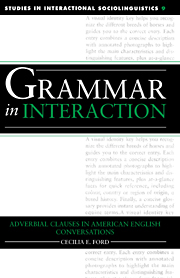Book contents
- Frontmatter
- Contents
- List of illustrations
- List of tables
- Acknowledgements
- Transcription conventions
- 1 Introduction
- 2 Overview of the conversational corpus
- 3 Initial adverbial clauses
- 4 Final versus initial adverbial clauses in continuous intonation
- 5 Final adverbial clauses after ending intonation
- 6 Comparison of clause types and apparent deviations from the general patterns
- 7 Conclusion
- Notes
- References
- Author index
- Subject index
3 - Initial adverbial clauses
Published online by Cambridge University Press: 09 November 2009
- Frontmatter
- Contents
- List of illustrations
- List of tables
- Acknowledgements
- Transcription conventions
- 1 Introduction
- 2 Overview of the conversational corpus
- 3 Initial adverbial clauses
- 4 Final versus initial adverbial clauses in continuous intonation
- 5 Final adverbial clauses after ending intonation
- 6 Comparison of clause types and apparent deviations from the general patterns
- 7 Conclusion
- Notes
- References
- Author index
- Subject index
Summary
In the present conversational corpus, initial adverbial clauses can be described in terms of the information patterns they form, and in terms of the interactional functions they serve. While the dichotomy between the information management or patterning and interactional functions of language is not a discrete one, there is value in approaching the description of adverbial clause usage with this division in mind. Because previous studies of adverbial clause usage have focused on monologue data, we know the kind of work such clauses do in less interactive discourse. That work has been described mainly in terms of information management. Prior studies have consistently pointed to a shift function for initial adverbial clauses. In monologue texts, such clauses set off prior discourse from discourse that follows. An initial adverbial clause uses information that has either appeared in some form in the previous discourse, or that follows sequentially from a point in the previous talk. Such information is either taken directly, negated or put in a contrasting form, or simply introduced as a possible option. The adverbial clause then constitutes explicit background for the following discourse.
With those findings as a source of comparison, we can look at the occurrence of adverbial clauses in conversation to see what such clauses do in encoding and organizing information and, additionally, in managing and maintaining interaction and the social roles of parties in conversations. It is assumed that information patterns, relations of these clauses to their textual environments, exist in conjunction with the interactional work that is being done at any point in a conversation.
- Type
- Chapter
- Information
- Grammar in InteractionAdverbial Clauses in American English Conversations, pp. 26 - 62Publisher: Cambridge University PressPrint publication year: 1993

